Movie Review – On Death Row: The Shawshank Redemption & The Green Mile
Prison movies have a long and proud history in Hollywood. Films such as Cool Hand…
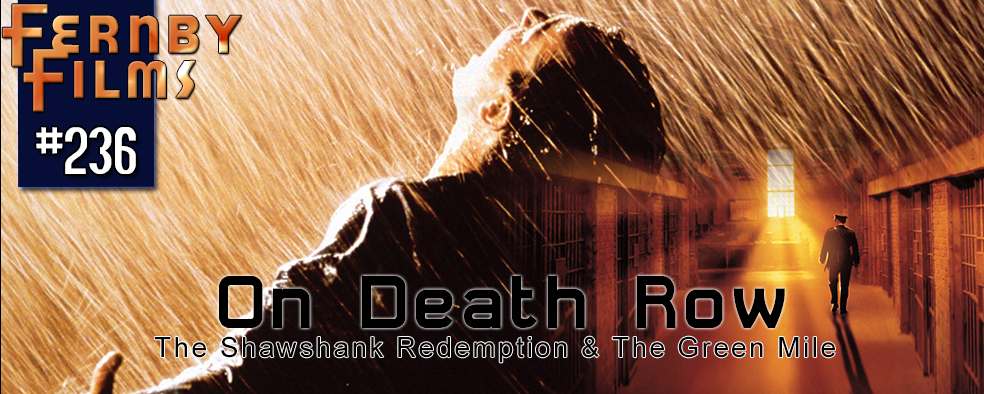
Prison movies have a long and proud history in Hollywood. Films such as Cool Hand Luke and Stallones Lock-Up have all, at one point, kept us in rapt attention to the plight of the modern-day inmate. While Hollywood’s idealised prisoner is traditionally the wrongly accused, or the murderer with a heart of gold, there are some films so perfectly realised by a filmmaker that they transcend the genre and become classics in their own right. The Shawshank Redemption, based on a Steven King short story (entitled Rita Hayworth & The Shawshank Redemption, published in Kings’ Different Seasons in 1982) appeared out of nowhere in 1994, and was given a generally lukewarm response by moviegoers around the world. Upon it’s release on home video and DVD, however, audiences warmed to the wonderful story of a man, accused of murdering his wife and her lover, who is thrown into prison, and the friendships he strikes up with fellow inmates. A few years later, the very same director gave another King work a shot at cinematic glory, with The Green Mile, a story set in a prison’s death row, and the men who guard those who have been sentenced to death. But the question remains, which of these two cinematic classics is the better prison film? Which would survive in solitary confinement? Which film deserves our critical version of a lethal injection? Strap on the handcuffs, jot down your last meal, and get set to find out!!
The second film from Frank Darabont to be based upon a work from Steven King, The Green Mile is a wonderful fable of magic, life, and an affirmation of the joy of living. Told from the perspective of Tom Hanks’ magnificent cell-block chief, and featuring an all-star cast, The Green Mile ranks as a superlative piece of film-making. Hanks is Paul Edgecomb, the chief officer on a 1930’s death row cell-block who is charged with the incarceration of an enormous negro man, John Coffey (like the drink, just not spelled the same…) who is on death row for the murder of two small girls. Coffey is an intimidating presence, although his persona appears incongruous to both his size and supposed crime. The more Paul digs into Coffey’s story, the more he comes to think that perhaps, this time, an innocent man really has been sentenced to death. In a film that defies popular cinematic conventions, The Green Mile seems more a meditation on the mysteries and indefinable moments in life, than a traditional prison film of redemption and reflection.
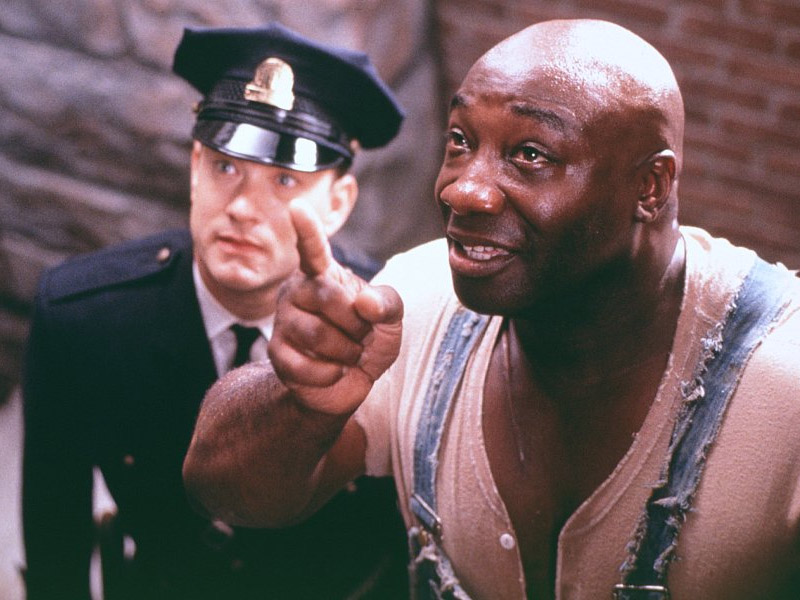
I have to admit, I didn’t think a film based upon Steven Kings short story about a prisoner escaping from a hard-nut jail, in one of the more inventive methods ever seen, would make such a moving, emotional film. For those who have read Kings original novel, you’ll know that the film version touches on almost every point in the original text, and often, expands on it. Violent, shocking, moving and, ultimately, uplifting, Shawshank is one of those films that really takes you on a journey as a cinematic event. Andy Defresne is sent to Shawshank Prison for the supposed murder of his wife and her lover, whom it is claimed Andy shot to death as a crime of passion. Upon arriving, he quickly befriends Ellis “Red” Redding (Morgan Freeman), a man who is known to “obtain certain artifacts from time to time” in order to get his hands on a rock hammer; Andy intends to chisel chess pieces from the stone in the yard. As the years go by, Andy discovers a way to prove that he is innocent, and sets about trying to obtain his freedom. Shawshank is a film made with a curious mix of classic style mixed with modern sensibilities. It’s like a Capra movie, only with a few F-Bombs thrown in. So how does it hold up against it’s longer, more recent cousin?
Look, nobody’s going to deny that prison would be a horrible place to be. As somebody who has, thankfully, never stepped foot inside a working, current prison, I can’t speak with any authority on the matter, but as a rule they’re designed as not very nice places to be. Prison is meant as a deterrent, not as a holiday camp. So I can only imagine the horrors and inhumanity that has taken place in some of the worlds worst prison systems. The worst scum of all goes into them, and often, this brings them into conflict with each other. And Hollywood has exploited this for all it’s worth throughout it’s long history. Mining the collective empathy of the masses through wrongful imprisonment and heart-of-gold inmates has long been a tradition on which the Prison Film genre has been successful. It goes without saying that in amongst the gems, such as Cool Hand Luke and perhaps, somehow, Bridge On The River Kwai, there’s been a number of turkeys. It’s fair to say that both Shawshank and The Green Mile are most definitely not turkeys.
Shawshank was released in a blaze of ho-hum critical analysis, lacklustre earnings ensuring a smooth transition quickly from cinemas, although this situation would eventually be repudiated with a nod by Oscar for Best Picture at the ’94 Academy Awards. While it may not have found an audience in it’s initial theatrical run, since it’s release on VHS and DVD has become a classic in it’s own right, so much so it’s even been listed in a gaggle of “best picture” lists ever since, usually in the top 10, if not number 1. Tim Robbins’ Andy Dufresne (pron. doo-FRAYNE), Morgan Freemans’ Red, and a beautiful number of wonderful acting performances by a cast of relative unknowns, make Shawshank one hell of a fine film.
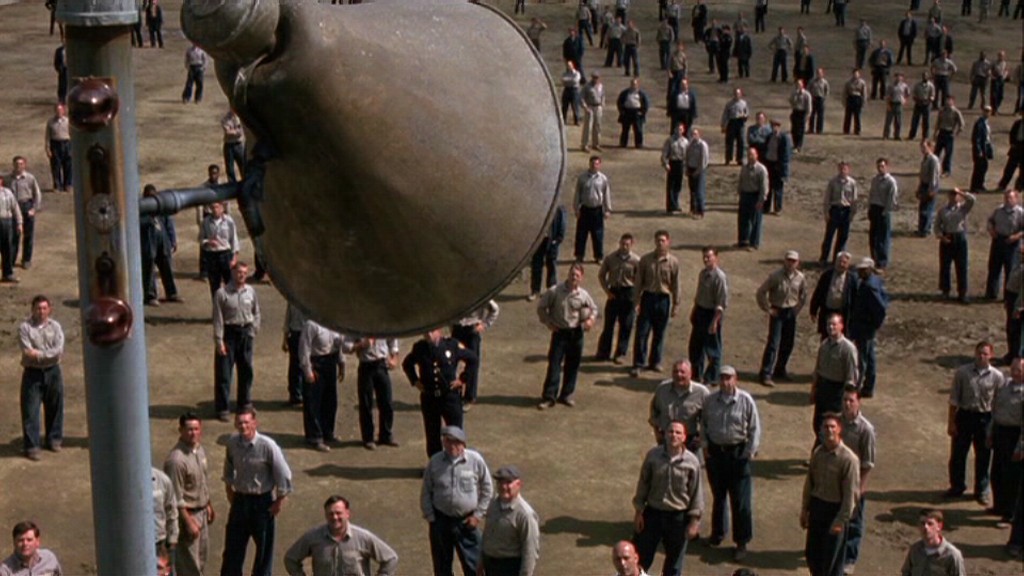
Actors like Bob Gunton as the slimy, reprehensible prison Warden, Clancy Brown as the vindictive, violent, chief guard Byron Hadley, as well as a heartbreaking portrayal of institutionalisation from James Whitmore as Brooks Hatlen, have permeated the popular consciousness and allowed Shawkshank to develop into a truly genuine cinematic, storytelling experience. That’s what director Frank Darabont has done with this film; turned a cleverly moving King story into a cleverly moving film. But for me, it’s more than a simple film, it’s a revelation of a movie that will always capture you no matter how many times you’ve seen it.
I look at what Darabont achieved with Shawshank Redemption and cannot help but become a fan of the man. The film moves slowly, like a good roast being cooked, allowing the sauces of the story to simmer and penetrate the narrative; each character, even ancillary ones, are not given short thrift here. Prison guards, fellow cons, even the most obscure character is allowed a moment to shine and develop his character. He’s used a traditional film mentality, the angles and edits of a classic forties genre piece, and given it a modern, Hollywood edge, something that perhaps shouldn’t work, but does. Just how did he translate a written story, told in about 100 pages, into a near three hour masterpiece? Often, Steven King’s works don’t make the transition to film all that well. Of course, there have been exceptions (Carrie, Cujo, The Shining, Stand By Me) but filmmakers have run aground on the shallow shoals of Kings literary accomplishments, more often than not failing to translate the feelings, the terror and emotional content King imbues his works with. With both Shawshank and Green Mile, though, Darabont has expanded the original text into works of cinematic superlative.
Both films manage to skirt sentimentality to a certain degree, at least in as much as the quality of people held within these prison walls. While the inmates in both films are portrayed as men, rather than animals or thugs (for the most part), complete with actual personalities and character, Darabont never delves into overt emotional manipulation with his portrayals of them. Andy and Red are firm friends, even if they do have their differences, and while Red has settled into his life within prison by the time Andy arrives, they soon become fast friends as Andy begins to do the same. Shawshanks naturalistic tone is preempted by a kind of easygoing-depression, a sense of dread and unease that at any minute violence could erupt: especially with Byron Hadley prowling the halls like a cooped-up jaguar. Darabont shows the violence and the depravity within Shawshanks walls in a way that’s believable without being overly morbid, a truthful style with a lack of gritty, bloodstained realism. The characters are given time to percolate, and in keeping with the films’ overarching theme of time being wasted in prison, this is a pertinent way of telling the tales of these men. Most of the inmates at Shawshank are genuinely guilty, although they’ll each say they aren’t. This juxtaposition of hopelessness mixed with despair is a constant ache in your mind as you watch. Men drawn into sullen violence and sadism as they see their lives as hopeless nothingness; Darabont draws fine performances from his cast. There’s not a foot put wrong here: not even from Gil Bellows, whose role here was his first major film performance. Bellows had the chance to completely take me out of this film, his time-capsule “dude with ‘tude” could be seen as something anachronistic, perhaps generically overdone, as far as the rest of the film is concerned. For me though, the underrated performance of the film is Mark Rolston’s amazingly slimy turn as Shawshank’s resident Bull Queer Bogs Diamond, who, with his gang of like-minded rapists, turn prison life into a hellhole for Andy and other inmates. Rolston radiates evil, of the most pure and unfettered kind, and with such ease it’s almost scary. A far cry from the more gung-ho Pvt Drake from Aliens!
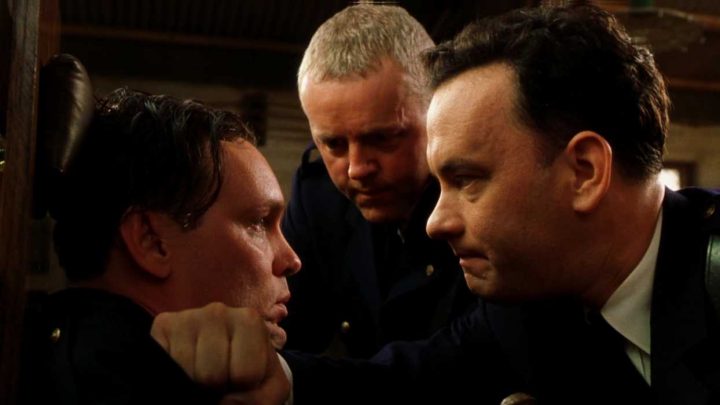 The Green Mile takes a different, yet similar tone to Shawshank. While Darabont crafts the characters and tone of the film through judicious editing and some long, loving camera angles, the cast themselves work hard to bring their portrayals to riveting life. Tom Hanks, who leads the film’s ripper cast, is magnificent as Paul Edgecombe, a blend of stern authoritarian boss and caring, family oriented God-fearing member of society. Edgecomb is initially unswerving in his following of the rules of the prison, particularly the Death Row ones, and when the mysteriously ambiguous John Coffey arrives to bring everything he knows into doubt, Edgecome does what anybody else might not do so well: he tries to understand. The Green Mile wouldn’t be the film it is without the performances of two specific individuals, neither of which is Tom Hanks. Michael Clarke Duncan, as John Coffey, delivers the best performance I have seen him give, and considering the buffoonery on display in films like Armageddon and Daredevil, that’s a fairly big call. Duncans emotive, captivating turn as the intellectually small Coffey, replete with the internal infractions of racism of the day (the film is set, predominantly, in the 40’s) is perfectly counterpointed by Hanks layered, smooth corrections officer. Both actors work off each other well, although Hanks substantially superior performance lifts Duncans above mere mediocrity and cliché. The other person who takes The Green Mile and lifts it into the realm of a classic is Doug Hutchison, who gave us a chilling portrayal of a serial-killer in Jamie Foxx’s criminally underrated Bait. Hutchison, here playing a vindictive, passive-aggressive misogynist in Percy Wetmore, the nephew of prison Warden Hal Moores (James Cromwell). Percy comes to Death Row so he can see a prisoner be executed, his fascination with death a contrast to the rest of those who guard the condemned, who seek to preserve life where possible. Hutchison is creepy as hell here, his malevolent and vindictive personality not exactly suited to life on the Mile. As the films central villain, of sorts, he’s a perfect choice.
The Green Mile takes a different, yet similar tone to Shawshank. While Darabont crafts the characters and tone of the film through judicious editing and some long, loving camera angles, the cast themselves work hard to bring their portrayals to riveting life. Tom Hanks, who leads the film’s ripper cast, is magnificent as Paul Edgecombe, a blend of stern authoritarian boss and caring, family oriented God-fearing member of society. Edgecomb is initially unswerving in his following of the rules of the prison, particularly the Death Row ones, and when the mysteriously ambiguous John Coffey arrives to bring everything he knows into doubt, Edgecome does what anybody else might not do so well: he tries to understand. The Green Mile wouldn’t be the film it is without the performances of two specific individuals, neither of which is Tom Hanks. Michael Clarke Duncan, as John Coffey, delivers the best performance I have seen him give, and considering the buffoonery on display in films like Armageddon and Daredevil, that’s a fairly big call. Duncans emotive, captivating turn as the intellectually small Coffey, replete with the internal infractions of racism of the day (the film is set, predominantly, in the 40’s) is perfectly counterpointed by Hanks layered, smooth corrections officer. Both actors work off each other well, although Hanks substantially superior performance lifts Duncans above mere mediocrity and cliché. The other person who takes The Green Mile and lifts it into the realm of a classic is Doug Hutchison, who gave us a chilling portrayal of a serial-killer in Jamie Foxx’s criminally underrated Bait. Hutchison, here playing a vindictive, passive-aggressive misogynist in Percy Wetmore, the nephew of prison Warden Hal Moores (James Cromwell). Percy comes to Death Row so he can see a prisoner be executed, his fascination with death a contrast to the rest of those who guard the condemned, who seek to preserve life where possible. Hutchison is creepy as hell here, his malevolent and vindictive personality not exactly suited to life on the Mile. As the films central villain, of sorts, he’s a perfect choice.
Both films could possibly be faulted for their length, and with Green Mile clocking in at a staggering three hours, you’d be forgiven for thinking Darabont had a penchant for lengthy, lethargic homilies to life in incarceration. But neither Shawshank or Green Mile feel like long films. A little like Lawrence Of Arabia, Ben Hur or Bridge On The River Kwai, film which are long yet need that length to generate their story momentum. I don’t mean to compare Darabont’s films to those genuine classics (only time will generate that kind of sentiment among the masses) but the point is valid in terms of length to quality of storytelling. I’ve always felt a long film allows time for the director (and subsequently, us as an audience) to develop and marinade the characters and narrative, giving the story time to unfold without having to cut, chop or otherwise mitigate any emotional content simply for the sake of an extra screening in the multiplex. The Green Mile is a story with many plot points, and often, wanders into substantial extra-curricular narratives from time to time; however, the events within the film always permeate back to, and around, the cell-block of Death Row, and the characters that dwell within. Shawshank deals almost exclusively with Andy and Red’s relationship, throwing in a few minor characters along the way, and while it’s a textbook ensemble piece, never really delves into the minor characters (save for Brooks Hatlen) to any level other than the ancillary. The main point, however, is that both films are long for a very good reason; they have a good story to tell, and more often than not you need to allow time to tell them.
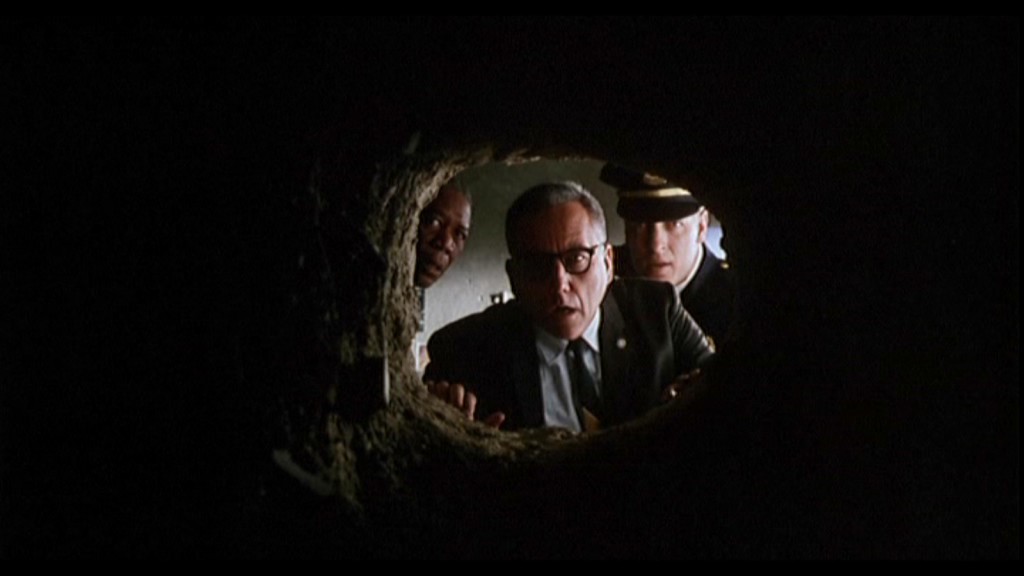
In the telling, both films rely on classic cinematic conventions: Shawshank relies on a semi-narration by Morgan Freeman, bridging time and space with a single, wonderfully intoned sentence. This narration runs throughout the film, almost as a flashback style (in the loose sense of the word) and it’s not until the films final act, with the release of Red from prison, that we come to “present day”. The Green Mile is told entirely in flashback, book-ended by an elderly Paul Edgecombe recounting his story while awaiting his demise in a retirement home, portrayed wonderfully by Dabbs Greer in one of his last major screen roles. This allows for a slow reveal of the lead characters ultimate fate, and engenders a historical context for the film that is more powerful than a simple “set in 1940” film would inspire. While the “moral” of the story as told by Greer is a little soft in terms of what’s come before (and smacks a little of Titanic’s oft-criticised obtuse central theme), The Green Mile does what it does with a minimum of fuss and a maximum of genuine love of cinematic storytelling. Humour, heartbreak, elation and violence, strung together by the spectre of death and redemption, both films tell similarly themed stories in different ways; each is uplifting and emotional, each one featuring wonderful performances and cinematic craft.
Of these two amazing films, which one would I like to be stuck in solitary confinement with, if I was only allowed one film to watch? Hard choice, as each film offers to explore something different about the human condition. Both films are critically acclaimed, and to be honest, even now as I write this conclusive paragraph, I am torn between the two in my decision. On what grounds would I appraise one over the other? Casting? Both have brilliant casts, most at the peak of their powers. Direction? Both films are beautifully rendered, immaculately edited and developed; on almost every front they’re stunning, from the scripting to the lighting to the production design in every frame. Story? Scripting on both is brilliant, multi-layered nuances abound in every scene, and multiple viewings of both films often highlight new moments and substance missed in initial perusals. Frank Darabont’s screenplays are defining moments in his career, his ability to take Steven Kings effusive writings and convert them successfully to stories that translate onto the screen so well. So it falls to the simple question: which is more enjoyable? perhaps that isn’t even the right question; it’s more pertinent to ask: which film is more entertaining? As hard as I tried, I couldn’t go past the switch-back twist in Shawshank as a great fist-pumping cinematic moment, and for this simple story element, The Shawshank Redemption rates the better film, but only by the barest of margins. Lights out gentlemen.
